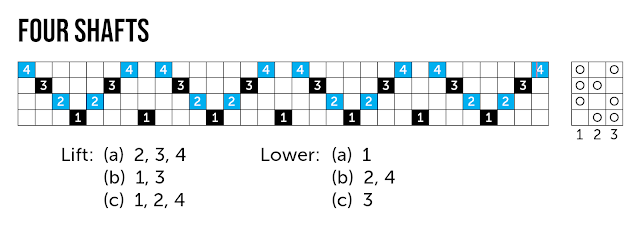I love krokbragd because of the infinite design possibilities on a simple warp. It's a kind of boundweave traditionally woven on 3-shaft point twill threading.

Weaving krokbragd takes a sequence of 3 picks that you'll repeat over and over. Think of the pattern in terms of which warp threads are DOWN, because that is where the weft thread will be on top and show up in the pattern. To weave krokbragd on three shafts:
(a) lower shaft 1,
(b) lower shaft 2,
(c) lower shaft 3.
...and repeat that sequence throughout the entire piece. The pattern comes out purely through which colors you use in what order; the treadling does not change at any point.
Many looms today are "rising shed" looms where the treadles lift up the shafts that they're connected to, instead of pulling them down as on an old-fashioned counterbalance loom. So, to weave krokbragd on a rising shed loom, you must lift up all of the shafts except the one that you want to stay down. In other words:
So that's all well and good, but not many of us actually have 3-shaft looms today. You're far more likely to have a 2- or 4-shaft loom. Can you still weave krokbragd?
No problem!
Krokbragd on 4 shafts
It is absolutely possible to weave krokbragd on a 4-shaft loom, using rosepath threading. To do this, you'll combine shafts 2 and 4, treating them together as a unit. Whether up or down, they will always act together.
Follow the a-b-c sequence below for which shafts to lift & lower, and you will produce exactly the same pattern as you would using the traditional point twill set-up on three shafts.
Straight twill threading (1-2-3-4) will also work for krokbragd, again by using shafts 2 & 4 together. But I generally prefer to use rosepath, because of all of the other pattern possibilities that you can get out of the same warp.
You can use my directions for
warping rosepath mug rugs to weave krokbragd, if you
change the tie-up following the diagram above.
Krokbragd on 2 shafts
Historically, it's not hard to see how krokbragd developed. A two-shaft loom is the simplest to design and construct. Adding just one more shaft makes it possible to create all sorts of new patterns, like krokbragd. If you have a two-shaft loom, it's not *too* hard to rig it up for weaving krokbragd by taking it just one step further.
Actually, one of the three sheds for traditional krokbragd is ready to go already. We're going to leave shaft 2 alone: it's attached to every other warp thread the whole way across, which is exactly what we need for one of the three krokbragd sheds. All we need to do now is divide the threads on shaft 1 in half to get our other two sheds.
Here's what to do:
(a) To make the first shed, lower shaft 1. Then lift back up every other thread on shaft 1 (colored orange in the draft below).
(b) To make the second shed, lower shaft 2.
(c) To make the third shed, lower shaft 1. Then lift back up the opposite set of threads on shaft 1 that you didn't lift before (colored green in the draft below).
How do you go about lifting back up half of the threads on shaft 1? You can use a pickup stick, you can rig your own heddle bar(s), or you can use two rigid heddles. There may be other methods too, but those are the first ones that come to mind.
On a final note, I weave with floating selvedges out of habit, which helps keep my edges tidy. The floating selvedges don't really slow down the weaving very much since this is such a slow method of weaving anyway. If you are weaving on just two shafts, you may or may not be able to use actual floating selvedges depending on your type of loom. Even if you can't have them actually "float," you can still include an extra thread on both edges of the warp, and manually insert your shuttle OVER the very first thread as you enter the shed and UNDER the very last thread as you exit on the other side. This will have the same effect as floating selvedges. There are other methods for keeping edges tidy without those extra threads, but I'm afraid that's too much to get into in this post.




Comments
Post a Comment